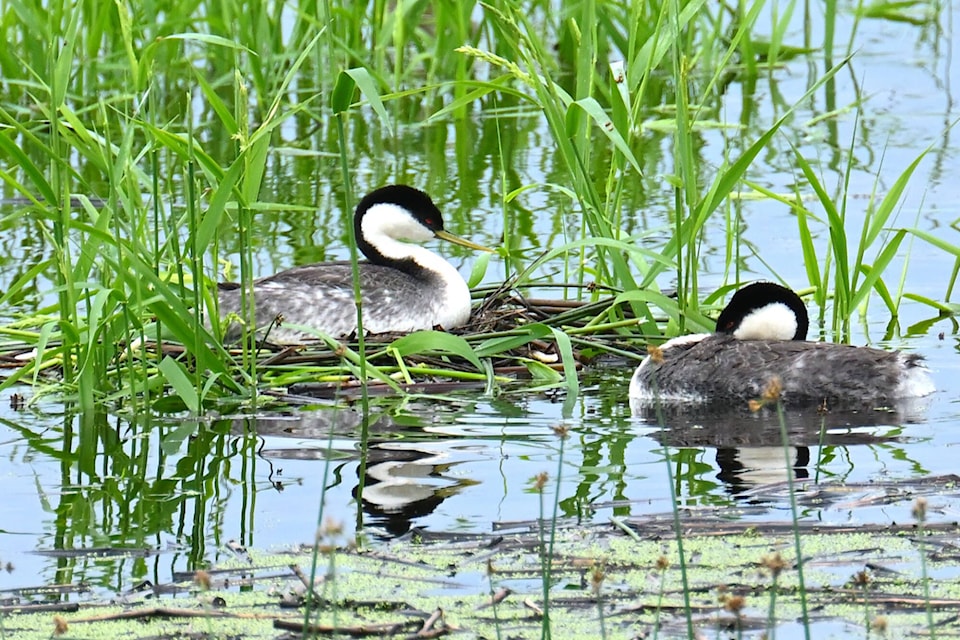By John G. Woods
Special to the Observer
I was fortunate to spot my first Western grebe nest of the year along the Salmon Arm Bay shoreline on May 24.
I watched from a distance with a spotting scope as one parent sat on the nest in incubation position. Every few minutes, its mate brought tidbits of vegetation to tuck here and there to further customize their homemade floating nest-island.
Nest renovations and incubation duties are constant tasks for nesting Western grebes.
Both parents share the maintenance workload and take turns keeping their eggs warm. When the sitting bird lifted to rearrange itself, I caught a glimpse of a single, light-coloured egg. Typically, these grebes have 2-3 eggs in a clutch, so I assumed that another egg would be on the way in a day or two.
Building nests as floating islands is a wonderful adaptation for a bird designed as a swimmer.
Their legs are ideally suited to swim-kicks but are too far back on their bodies to make walking easy. A floating nest allows the parents a stealth, underwater approach. This helps protect them from shore-based predators such as mink and coyotes.
Although usually attached to emergent vegetation, the nest can move up and down to some degree with changing water levels.
Not surprisingly, young grebes can swim as soon as they hatch. This gives the family mobility so they can move quickly to deeper and safer waters to feed. Baby grebes scramble onto their parent’s backs when they need to rest or for extra close protection from potential danger.
Getting through the 24-day egg incubation period is the chief challenge for the grebe families to-be. Human disturbance from boating, airborne attacks by eagles and gulls, rapid changes in water level and violent weather can all cause nesting failure.
The annual “No Watercraft” zone, April 15 to Aug.15, identified by lines of white buoys visible either side of the Salmon Arm wharf, is probably our best contribution to helping the Western grebe nesting colony. Not only are grebes very sensitive to potential predators coming from the water, disturbance can cause them to leave their nests undefended and make their eggs and young easy prey for scavenging birds.
Since this is the sole surviving Western grebe nesting colony of any size in the British Columbia, we can take collective pride in helping the grebes by respecting this seasonal closure as the grebes put all their energy to the tasks of egg-hatching and rearing young.
Read more: COLUMN: Appreciating the bird-watching bounty of Salmon Arm Bay
Read more: Column: ‘Fish ducks’ put on quite a show near Salmon Arm wharf
Violent summer storms creating high onshore waves also can challenge the colony by damaging nests and tipping unhatched eggs into the water. This threat to nesting success underlines the importance of protecting all potential nesting habitat around the Bay shoreline so that no one storm is likely to obliterate all the nests.
Rapid changes in water levels, something we have seen dramatically this spring, can also work against nesting success. Significant increases or decreases could either flood nests or leave them marooned on a mudflat.
Local wildlife biologist, Di Wittner, has been taking annual censuses of the grebes in the bay for several years on behalf of the Shuswap Naturalist Club. She makes her first count before the young hatch and again later in the summer, when most of the young should be in the open waters of the bay with their parents.
Her most recent census on May 28 this spring totaled 283 adult grebes across nine areas of the bay. This isn’t too far off the 315 adults she tallied at the same time last year. In mid-August, the count will be repeated to reveal how many young survived the perilous nesting period.
On a personal level, I’m hoping that the egg I observed on May 24 will make it to its calculated hatching date on June 16, and become one of the juveniles we see begging food from their parents later in the summer.
newsroom@saobserver.net
Like us on Facebook and follow us on Twitter
